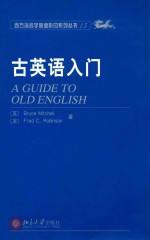
- 作 者:(英)Bruce Mitchell (美)Fred C.Robinson著
- 出 版 社:
- 出版年份:2005
- ISBN:
- 标注页数:0 页
- PDF页数:427 页
请阅读订购服务说明与试读!
订购服务说明
1、本站所有的书默认都是PDF格式,该格式图书只能阅读和打印,不能再次编辑。
2、除分上下册或者多册的情况下,一般PDF页数一定要大于标注页数才建议下单购买。【本资源427 ≥0页】
图书下载及付费说明
1、所有的电子图书为PDF格式,支持电脑、手机、平板等各类电子设备阅读;可以任意拷贝文件到不同的阅读设备里进行阅读。
2、电子图书在提交订单后一般半小时内处理完成,最晚48小时内处理完成。(非工作日购买会延迟)
3、所有的电子图书都是原书直接扫描方式制作而成。
How to Use this Guide 1
PART ONE 1
1 Preliminary Remarks on the Language(§§1-4) 11
2 Orthography and Pronunciation(§§5-9) 13
ⅰ Orthography(§5) 13
ⅱ Stress(§6) 13
ⅲ Vowels(§7) 14
ⅳ Diphthongs(§8) 14
ⅴ Consonants(§9) 15
3 Inflexions(§§10-135) 17
Introduction(§§10-14) 17
ⅰ Pronouns(§§15-21) 18
ⅱ Nouns and Sound-Changes Relevant to Them(§§22-62) 19
Weak Nouns(§§22-25) 19
Some Technical Terms(§§26-32) 20
Strong Nouns like stān(masc.)and scip(neut.)(§§33-44) 22
Masculine and Neuter Nouns in-e(§§45-46) 26
Strong Feminine Nouns(§§47-51) 27
i-Mutation(§§52-57) 28
Nouns affected byi-Mutation(§§58-60) 29
u-Nouns(§§61-62) 30
ⅲ Adjectives(§§63-76) 30
Introduction(§§63-64) 30
Weak Declension(§65) 31
Strong Declension(§§66-67) 31
Stem Changes in Adjectives(§§68-73) 32
Comparison of Adjectives(§§74-76) 33
ⅳ Observations on Noun,Adjective,and Pronoun Declensions(§§77-81) 33
ⅴ Numerals(§§82-86) 34
ⅵ Strong Verbs and Sound-Changes Relevant to Them(§§87-114) 35
Introduction(§§87-89) 35
Principal Parts of the Strong Verbs(§§90-95) 36
Breaking(§§96-99) 38
Influence of Initial?,sc,?(§100) 39
Influence of Nasals(§101) 40
Summary of the Strong Verbs of Class Ⅲ(§102) 40
The Effects of Sound-Changes on other Strong Verbs(§103) 40
Strong Verbs of Class Ⅶ(§104) 41
Grimm's Law and Verner's Law(§§105-109) 41
Conjugation of the Strong Verb(§§110-114) 43
ⅶ Weak Verbs and Sound-Changes Relevant to Them(§§115-126) 46
Introduction(§115) 46
Class 1(§§116-123) 46
Class 2(§§124-125) 49
Class 3(§126) 50
ⅷ Anomalous Verbs(§§127-130) 51
Bēon(§127) 51
Dōn and gān(§128) 51
Willan(§129) 51
Preterite-Present Verbs(§130) 52
ⅸ Is a Verb Strong or Weak?To which Class does it Belong?(§§131-134) 52
ⅹ Adverbs(§135) 53
Formation(§135) 53
Comparison(§135) 54
4 Word Formation(§§136-138) 55
Introduction(§136) 55
ⅰ Compounding(§137) 56
ⅱ The Addition of Affixes(§138) 57
Prefixes(§138) 58
Suffixes(§138) 59
5 Syntax(§§139-214) 61
Introduction(§§139-142) 61
ⅰ Word-Order(§§143-147) 63
ⅱ Sentence Structure(§§148-153) 66
Recapitulation and Anticipation(§148) 66
The Splitting of Heavy Groups(§149) 67
Correlation(§§150-153) 68
ⅲ Noun Clauses(§§154-161) 70
Introduction(§154) 70
Dependent Statements and Desires(§§155-156) 70
Dependent Questions(§§157-160) 72
The Accusative and Infinitive(§161) 75
ⅳ Adjective Clauses(§§162-165) 75
Definite Adjective Clauses(§§162-163) 75
Indefinite Adjective Clauses(§164) 79
Mood(§165) 80
ⅴ Adverb Clauses(§§166-181) 81
Introduction(§§166-167) 81
Non-Prepositional Conjunctions(§168) 83
Prepositional Conjunctions(§§169-171) 88
An Exercise in Analysis(§172) 91
Clauses of Place(§173) 92
Clauses of Time(§174) 93
Clauses of Purpose and Result(§175) 94
Causal Clauses(§176) 95
Clauses of Comparison(§177) 96
Clauses of Concession(§178) 96
Clauses of Condition(§179) 97
Adverb Clauses Expressing Other Relationships(§180) 99
Other Ways of Expressing Adverbial Relationships(§181) 99
ⅵ Parataxis(§§182-186) 99
Introduction(§§182-183) 99
List of Conjunctions and Adverbs Commonly Used(§184) 101
Parataxis without Conjunctions(§185) 102
Some Special Idioms(§186) 103
ⅶ Concord(§187) 103
1.Nouns,Pronouns and their Modifiers(§187) 103
2.Pronouns and their Antecedents(§187) 104
3.Subject and Verb(§187) 104
ⅷ The Uses of the Cases(§§188-192) 105
Nominative(§188) 105
Accusative(§189) 105
Genitive(§190) 105
Dative(§191) 106
Instrumental(§192) 106
ⅸ Articles,Pronouns,and Numerals(§§193-194) 106
Articles and Pronouns(§193) 106
Numerals(§194) 107
ⅹ Verbs(§§195-212) 108
The Uses of the Present and Preterite Tenses(§§195-198) 108
The Resolved Tenses(§§199-204) 109
Introduction(§199) 109
The Verb'to have'as an Auxiliary(§200) 110
The Verb'to be'as an Auxiliary of Tense(§201) 110
The Passive(§§202-203) 111
Other Uses of the Present and Past Participles(§204) 111
The Uses of the Infinitives(§205) 112
The'Modal'Auxiliaries(§§206-211) 113
Introduction(§206) 113
Magan(§207) 113
Mōtan(§208) 114
Cunnan(§209) 114
Sculan(§210) 114
Willan(§211) 115
Impersonal Verbs(§212) 116
ⅹⅰ Prepositions(§§213-214) 116
6 An Introduction to Anglo-Saxon Studies(§§215-251) 118
ⅰ Some Significant Dates(§§215-216) 118
ⅱ History(§§217-218) 118
ⅲ Archaeology(§§219-230) 124
Introduction(§219) 124
List of Abbreviated Titles(§220) 125
Weapons and Warfare(§221) 127
Life and Dress(§222) 127
Architecture and Buildings(§§223-224) 128
Sculpture and Carving(§225) 129
Jewellery and Metalwork(§226) 130
Embroidery(§227) 130
Coins(§228) 131
Manuscripts and Runic Inscriptions(§229) 131
The Sutton Hoo Ship-Burial(§230) 131
ⅳ Language(§§231-235) 132
Changes in English(§231) 132
The Danish Invasions(§232) 133
The Norman Conquest(§233) 133
Vocabulary(§234) 134
Some Questions(§235) 135
ⅴ Literature(§§236-251) 135
Introduction(§§236-246) 135
Poetry(§§247-249) 141
Prose(§§250-251) 142
7 Select Bibliography(§§252-269) 144
General(§252) 144
Chapter 1 Preliminary Remarks on the Language(§253) 144
Chapter 2 Orthography and Pronunciation(§254) 145
Chapter 3 Inflexions(§254) 145
Chapter 4 Word Formation(§255) 145
Chapter 5 Syntax(§256) 145
Chapter 6 Introduction to Anglo-Saxon Studies(§§257-269) 146
History(§)257) 146
Archaeology(§258) 146
Language(§§259-261) 147
History of English Prose(§259) 147
Vocabulary(§§260-261) 147
Word Formation(§259) 147
Changes of Meaning(§260) 147
Borrowings(§261) 147
Literature(§§262-269) 148
Topics raised in §§236-246(§262) 148
General Criticism(§263) 148
Poetry Texts(§264) 148
Appreciation of the Poetry(§265) 150
The Use of Oral Formulae(§266) 150
Metre(§267) 150
Prose Texts(§268) 151
Sources(§269) 151
Appendix A Strong Verbs 152
Appendix B Some Effects of i-Mutation 159
Appendix C Metre 161
PART TWO:PROSE AND VERSE TEXTS 171
1 Practice Sentences 171
2 Two Old Testament Pieces 173
The Fall of Man 174
Abraham and Isaac 178
3 A Colloquy on the Occupations 182
4 Two Characteristic Prose Works by ?lfric Preface to Genesis 190
St.Edmund,King and Martyr 195
5 Alfred the Great's Preface to his Translation of Gregory's Pastoral Care 204
6 Cynewulf and Cyneheard 208
7 Selections from the Anglo-Saxon Chronicle 212
8 Bede's Account of the Conversion of King Edwin 216
9 Bede's Account of the Poet C?dmon 220
10 The Goths and Boethius:Prose and Verse from the Introduction to King Alfred's Boethius Translation 226
11 (a)-(p)Riddles 231
12 The Battle ofMaldon 241
13 The Ruin 253
14 The Dream of the Rood 256
15 The Wife's Lament 264
16 The Wanderer 268
17 The Seafarer 276
18 Four excerpts from Beowulf 283
(a)Beowulf's Fight with Grendel 284
(b)Beowulf Consoles Hrothgar for ?schere's Death 291
(c)The Lament of the Last Survivor 294
(d)Beowulf's Funeral 295
19 Wulfand Eadwacer 297
20 Judith 300
A Note on the Punctuation of Old English Poetry 313
Glossary 317
Indexes to Part One 391
Index of Subjects 391
Index of Words 395
